The Google Nexus 7 Review
by Anand Lal Shimpi & Brian Klug on July 26, 2012 11:35 AM ESTThe Display
In this new age of high resolution panels with small dimensions, the goal seems to be to just get the display out of the way. You shouldn't notice the display, it should just quietly do its job and make you believe that what you're looking at is real. When viewed with this critical eye, very few displays do their job well.
The Nexus 7's display is somewhere between good and perfection. It's not on the latter end of the spectrum, but it's great for $199. Black levels are good, and max brightness is more than enough for indoor use, although you'll have problems outdoors if it's too sunny.
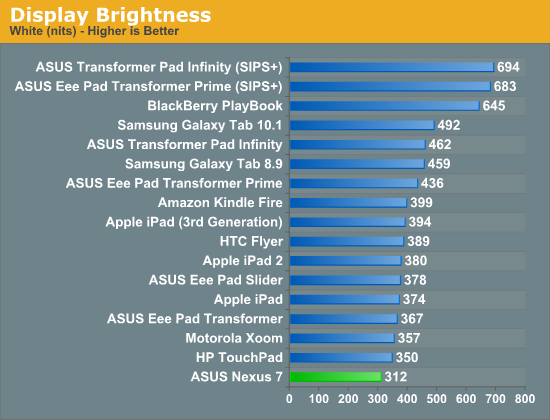
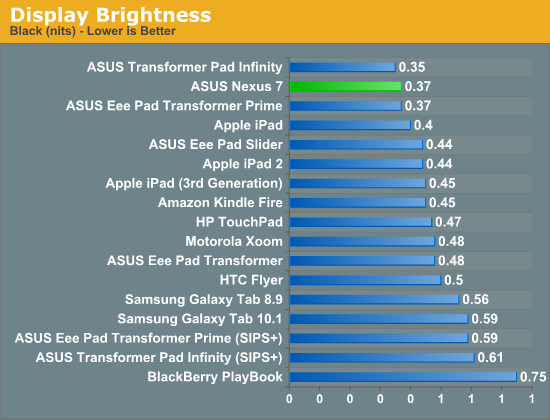

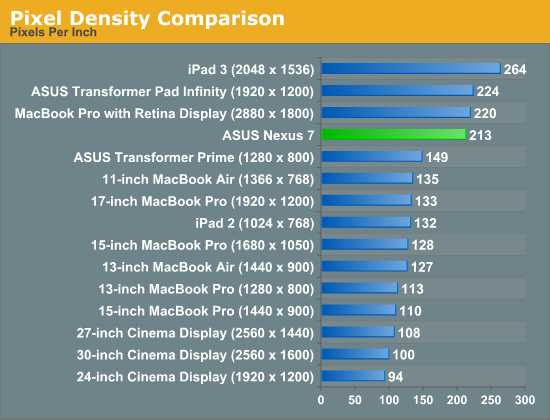
The resolution is high enough that neither Brian nor I were able to identify individual pixels at our normal viewing distances. Images do look better on the new iPad however (not a resolution but rather a panel advantage).
The other interesting aspect of the Nexus 7 is that it is a relatively new and somewhat interesting display form factor. 213 pixels per inch in a 7 inch display is unique for an Android tablet, and puts the Nexus 7 in the "tvdpi" screen density category for Android, 600 x 961 dp (that's dp - density independent pixels, relative to 160 ppi).
The end result is that some applications get a scaled down version of the 10" form factor Android 4.x UI, others don't. Some pages use the phone layout (for example the settings page, play store, and the notifications shade), others use the tablet two pane layout (for example Gmail) due to the 600dp width of the Nexus 7. That is to say it isn't totally correct to say that the UI on the Nexus 7 is a larger, scaled version of the phone UI, but something of an intermediary between the traditional 10" tablet version, and the phone version depending on what the break point is (in dps) for the particular app.
The other interesting note is that because 'tvdpi' isn't a primary display density for Android developers to build assets against, most often bitmaps get scaled down from the hdpi asset. In most places there isn't much of a noticeable softening of the edges, but I'll admit there are a few places where it's obvious bitmaps have been decimated and look a bit soft. Luckily, the pixel density of the display itself is high enough to mask most of this, but it isn't always perfect.
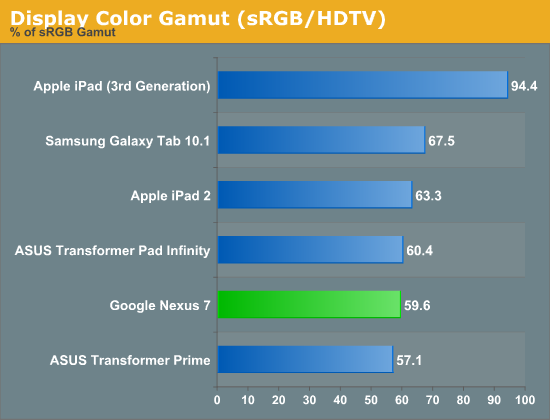
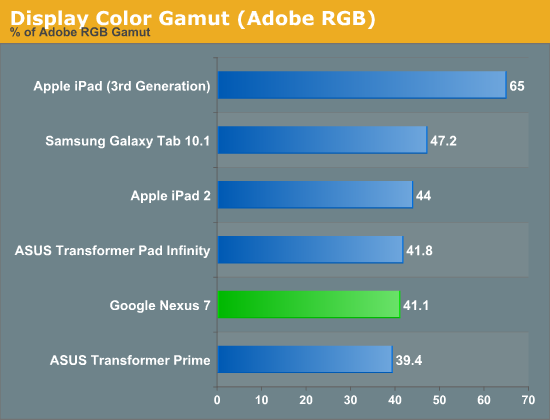
The Nexus 7's IPS panel offers great viewing angles, something that's simply a requirement for any device whose primary interface revolves around the display. Color accuracy is simply middle of the road, but I don't expect many users to do a lot of professional photo editing on the Nexus 7 so I'm not sure how much this actually matters.


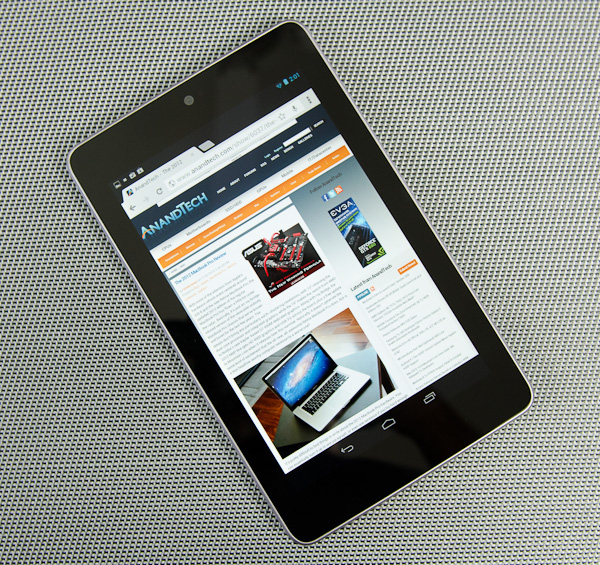








118 Comments
View All Comments
dcollins - Thursday, July 26, 2012 - link
Not everyone is like you.All my music lives in Spotify and I stream the vast majority of the movies/tv shows I watch. Plus, 90% of my tablet time is spent reading or browsing anyways.
Expandable storage is nice, but it certainly is not a blocking issue for my usage.
CeriseCogburn - Sunday, July 29, 2012 - link
I love that how all the screaming for future proof options is out the window.Steve Jobs loves it too.
robinthakur - Tuesday, July 31, 2012 - link
Agree. I think the Retina Macbook is the poster boy for this though. Not having upgradeable ram on a £2500 laptop is pretty inexcusable. What if I need more than 16GB to run virtual machines etc? It's the only thing which keeps me from buying one.dmyster - Thursday, July 26, 2012 - link
well, I have a pretty good set up at home for streaming most media to tablets and media devices. The extra 50 bucks for 16 gig was not worth it to me since I will not be traveling with it. I can watch all my movies, listen to all the songs in my library and read books. There are some decent apps - stock ticker, netflix, skype to mention a few. For 200 bucks it is a good deal if you can do without the extra storage or a sd card which I can...Impulses - Friday, July 27, 2012 - link
Root it, install Stickmount, use any removable media with a USB OTG cable. If there was a better 7" alternative for $50 more or even $100 more that comment might make more sense... But as it is, the Nexus 7 is still a fantastic device and unless you're very tech averse the lack of expandable storage out of the box really isn't a big deal...I'd even take a gamble that most people who'd balk at rooting the thing will probably never store enough media or games on it to really have an issue with 16GB, the 8GB model will be tight if you start to download big games left and right tho.
CeriseCogburn - Sunday, July 29, 2012 - link
Boy you have no clue on the public and general end users.Let me help.
They are utterly clueless, and when faced with storage constraints, they have no idea what to do, and deleting for space is above their user skills.
That's the vast majority of purchasers.
TheJian - Wednesday, August 1, 2012 - link
Don't confuse apple users with Android users :)We don't call them SHEEPLE for nothing ;)
A large portion of Android users are above the norm and believe in using their devices for more than Steve Jobs every believed you should get away with.
NoNeedForMonkeys - Saturday, August 4, 2012 - link
Perhaps you should burn every iOS device for not having expandable storage.lunarx3dfx - Thursday, July 26, 2012 - link
http://www.androidcentral.com/why-nexus-devices-ha...That article talks about the lack of SD cards, and honestly it makes sense to me. Also, keep in mind that they do have a 16 GB Nexus 7 available for purchase. Although, I think it's currently sold out.
CeriseCogburn - Sunday, July 29, 2012 - link
Of course it's sold out.